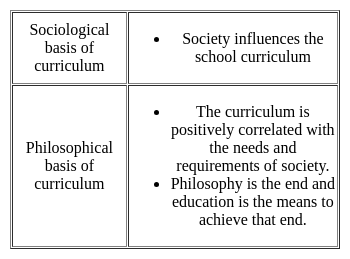Software Development Exam > Software Development Tests > Test: Education & Leadership (Syllabus and Curriculum) - Software Development MCQ
Test: Education & Leadership (Syllabus and Curriculum) - Software Development MCQ
Test Description
20 Questions MCQ Test - Test: Education & Leadership (Syllabus and Curriculum)
Test: Education & Leadership (Syllabus and Curriculum) for Software Development 2025 is part of Software Development preparation. The Test: Education & Leadership (Syllabus and Curriculum) questions and answers have been prepared
according to the Software Development exam syllabus.The Test: Education & Leadership (Syllabus and Curriculum) MCQs are made for Software Development 2025 Exam.
Find important definitions, questions, notes, meanings, examples, exercises, MCQs and online tests for Test: Education & Leadership (Syllabus and Curriculum) below.
Solutions of Test: Education & Leadership (Syllabus and Curriculum) questions in English are available as part of our course for Software Development & Test: Education & Leadership (Syllabus and Curriculum) solutions in
Hindi for Software Development course.
Download more important topics, notes, lectures and mock test series for Software Development Exam by signing up for free. Attempt Test: Education & Leadership (Syllabus and Curriculum) | 20 questions in 20 minutes | Mock test for Software Development preparation | Free important questions MCQ to study for Software Development Exam | Download free PDF with solutions
Test: Education & Leadership (Syllabus and Curriculum) - Question 1
In which curriculum approach, the students always have the opportunity to revise the content in the coming classes?
Detailed Solution for Test: Education & Leadership (Syllabus and Curriculum) - Question 1
Test: Education & Leadership (Syllabus and Curriculum) - Question 2
Which of the following plan consists whole sum of the curriculum?
Detailed Solution for Test: Education & Leadership (Syllabus and Curriculum) - Question 2
Test: Education & Leadership (Syllabus and Curriculum) - Question 3
Which of the following is the best example of behaviorism while constructing curriculum?
Detailed Solution for Test: Education & Leadership (Syllabus and Curriculum) - Question 3
Test: Education & Leadership (Syllabus and Curriculum) - Question 4
Which of the following is not a feature of curriculum?
Detailed Solution for Test: Education & Leadership (Syllabus and Curriculum) - Question 4
Test: Education & Leadership (Syllabus and Curriculum) - Question 5
The term "Curriculum" has been derived from a Latin word "Currere" which means :-
Detailed Solution for Test: Education & Leadership (Syllabus and Curriculum) - Question 5
Test: Education & Leadership (Syllabus and Curriculum) - Question 6
Which of the following is known as formal curriculum?
Detailed Solution for Test: Education & Leadership (Syllabus and Curriculum) - Question 6
Test: Education & Leadership (Syllabus and Curriculum) - Question 7
The nature of the school curriculum should be agreed with
Detailed Solution for Test: Education & Leadership (Syllabus and Curriculum) - Question 7
Test: Education & Leadership (Syllabus and Curriculum) - Question 8
Overt curriculum is also known as ___________
Detailed Solution for Test: Education & Leadership (Syllabus and Curriculum) - Question 8
Test: Education & Leadership (Syllabus and Curriculum) - Question 9
Which of the following statement is NOT correct in the context of the curriculum?
Detailed Solution for Test: Education & Leadership (Syllabus and Curriculum) - Question 9
Test: Education & Leadership (Syllabus and Curriculum) - Question 10
Teachers could be effective improvers of the curriculum because:-
Detailed Solution for Test: Education & Leadership (Syllabus and Curriculum) - Question 10
Test: Education & Leadership (Syllabus and Curriculum) - Question 11
Which of the below is a true statement?
Detailed Solution for Test: Education & Leadership (Syllabus and Curriculum) - Question 11
Test: Education & Leadership (Syllabus and Curriculum) - Question 12
The complete set of taught material in the school system is also known as
Detailed Solution for Test: Education & Leadership (Syllabus and Curriculum) - Question 12
Test: Education & Leadership (Syllabus and Curriculum) - Question 13
Syllabus is best defined as:
Detailed Solution for Test: Education & Leadership (Syllabus and Curriculum) - Question 13
Test: Education & Leadership (Syllabus and Curriculum) - Question 14
The document that sets the standards of Curriculum is:
Detailed Solution for Test: Education & Leadership (Syllabus and Curriculum) - Question 14
Test: Education & Leadership (Syllabus and Curriculum) - Question 15
Which term is used to express the totality of the learning experiences that the pupil receives through manifold activities in the school?
Detailed Solution for Test: Education & Leadership (Syllabus and Curriculum) - Question 15
Test: Education & Leadership (Syllabus and Curriculum) - Question 16
The use of objective based teaching and testing does not include :-
Detailed Solution for Test: Education & Leadership (Syllabus and Curriculum) - Question 16
Detailed Solution for Test: Education & Leadership (Syllabus and Curriculum) - Question 17
Test: Education & Leadership (Syllabus and Curriculum) - Question 18
How many broad categories of the curriculum are there?
Detailed Solution for Test: Education & Leadership (Syllabus and Curriculum) - Question 18
Test: Education & Leadership (Syllabus and Curriculum) - Question 19
Why are curriculum activities used in teaching?
Detailed Solution for Test: Education & Leadership (Syllabus and Curriculum) - Question 19
Test: Education & Leadership (Syllabus and Curriculum) - Question 20
Which of the following falls under Psychological bases of curriculum?
Detailed Solution for Test: Education & Leadership (Syllabus and Curriculum) - Question 20
Information about Test: Education & Leadership (Syllabus and Curriculum) Page
In this test you can find the Exam questions for Test: Education & Leadership (Syllabus and Curriculum) solved & explained in the simplest way possible.
Besides giving Questions and answers for Test: Education & Leadership (Syllabus and Curriculum), EduRev gives you an ample number of Online tests for practice
Download as PDF



















